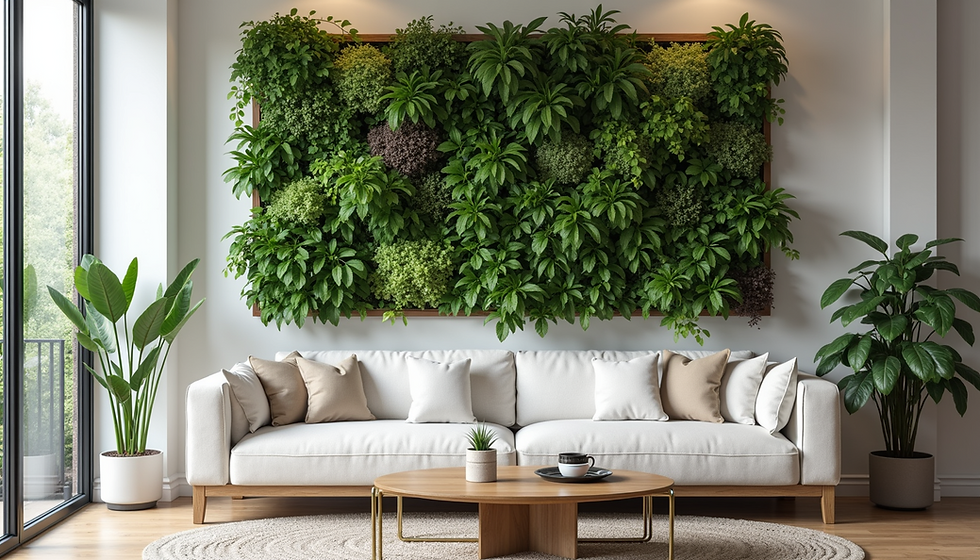Experience the Magic of Vertical Garden Design
- Allian Omar Mejias Leiva
- Jul 21
- 4 min read
Updated: Jul 28
Vertical gardens have gained significant prominence in the decoration and design of urban spaces. These “decorative green walls” not only beautify environments but also offer environmental and wellness benefits. In this article, we will explore what vertical gardens are, their advantages, and some iconic examples from around the world.
What Are Vertical Gardens?
Vertical gardens are structures that allow plants to grow vertically by using walls and surfaces as support. These installations can be placed indoors or outdoors and typically include a growing medium to nourish the plants, along with irrigation and drainage systems. They can be implemented in a wide variety of spaces—from offices to balconies—and contribute to a contemporary and natural aesthetic.

Beyond their visual appeal, vertical gardens promote sustainability and energy efficiency. They act as thermal insulators, help purify the air, and can reduce noise pollution. In an era where green space is increasingly limited, these installations serve as true urban lungs.
The Advantages of Decorative Green Walls
Decorative green walls offer numerous benefits that go beyond their aesthetic appeal. Below are some of the most relevant advantages:
Air Quality Improvement
Vertical gardens help filter air pollutants. Plants absorb carbon dioxide and release oxygen, contributing to a healthier environment. Studies have shown that green spaces can reduce air pollutants by up to 30%.
Thermal Insulation
Vegetation acts as an insulating layer, reducing the amount of energy needed to heat or cool a building. This results in significant energy savings. In hot climates, green walls help keep interiors cool, while in colder climates, they provide an additional barrier against the cold.
Aesthetics and Wellbeing
Green walls enhance the visual appeal of any space, creating a calming and natural atmosphere. They have been linked to improved mood, reduced stress, and increased productivity in both residential and commercial settings.
Decorative green walls bring a natural element to urban environments, creating a welcoming and relaxing atmosphere. The connection with nature enhances emotional well-being and reduces stress. Being surrounded by plants has been shown to boost productivity in workspaces and provides a visually engaging experience.
What Are the Best Vertical Gardens in the World?
There are several stunning examples of vertical gardens around the globe. Here are some of the most outstanding:
1. Le Mur Végétal by Patrick Blanc – Paris
This vertical garden, designed by botanist Patrick Blanc, is a masterpiece of nature and architecture. Located at the Musée du Quai Branly, it features over 15,000 plants from 150 different species. Its biodiversity and aesthetic design make it an iconic example of decorative green walls in urban spaces.

2. Bosco Verticale – Milan
This architectural project, consisting of two residential towers covered in greenery, has received numerous awards. With over 9,000 trees and thousands of plants, Bosco Verticale is an outstanding example of how nature and urban development can coexist in harmony.
3. Green Wall at the Georgia Institute of Technology – USA
This innovative design not only enhances the campus visually but also serves an educational purpose. The vertical garden offers a space where students can learn about ecology and sustainability while enjoying the visual appeal of lush greenery.
How to Design Your Own Vertical Garden
If you're interested in creating a vertical garden in your home or office, here are some essential steps to get started:
Choose the Right Space
The first step is selecting a suitable location. Consider the amount of sunlight the area receives and the positioning of the irrigation system. Vertical gardens can be adapted to different climates, but it’s important to choose plants that are appropriate for the environment.
Select the Right Plants
Plant selection is key. It’s best to choose species that thrive in the given space and have similar maintenance needs. Herbs, succulents, and foliage plants are popular choices for vertical gardens.
Design the Structure
You can build your own structure using recycled materials or purchase pre-designed systems that suit your needs. Make sure the system includes proper drainage and is strong enough to support the weight of the plants and growing medium.

Take Care of Your Garden
Once your vertical garden is installed, proper maintenance is essential. Make sure your plants receive the right amount of water and nutrients. A drip irrigation system can be a great investment to simplify care and ensure consistent hydration.
Inspiration and Creativity
Vertical gardens offer endless opportunities for creativity. You can experiment with different colors, textures, and plant species to create a unique design. Patterns can range from minimalist styles to lush and vibrant compositions—your imagination is the only limit.
You can also incorporate decorative elements like lighting or art. This not only enhances the beauty of the space but also allows you to express your personal style. Keep in mind that thoughtful planning is key to achieving a design that is both visually appealing and functional.
The Importance of Vertical Gardens for the Future
Interest in vertical gardens is growing rapidly. As cities expand and natural areas shrink, green walls have become a practical and impactful solution. They help combat pollution and global warming while improving urban quality of life.
Installing a vertical garden is not only a decorative choice—it's a conscious step toward a more sustainable future. So, if you’ve ever thought about transforming your environment, consider adding a vertical garden to your home or workplace.
Vertical gardens are a beautiful way to connect nature with urban life, promoting healthier and more inspiring spaces. Dare to bring them into your everyday life!



Comments